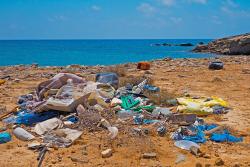£1.85m study to investigate microbes “hitch-hiking” on marine plastics
Experts at Bangor University are working with the Universities of Stirling and Warwick on a new £1.85 million project investigating how marine plastics transport bacteria and viruses – and the impact that may have on human health.
 Wherever you are in the world, you'll find litter along the shoreline.The scientists are aiming to understand how plastics act as vehicles, with the potential to spread pathogens within coastal zones, or even from country to country, and how that affects health.
Wherever you are in the world, you'll find litter along the shoreline.The scientists are aiming to understand how plastics act as vehicles, with the potential to spread pathogens within coastal zones, or even from country to country, and how that affects health.
Environmental biologist Dr Richard Quilliam at the University of Stirling is principal investigator on the new study, funded by the Natural Environment Research Council (NERC).
“While the impacts of marine plastics on wildlife are already well known, little research has been carried out to understand potential human health hazards posed by pathogens bound to their surface,” explained Dr Quilliam. “Our study will consider how pathogens bind to plastics in the ocean and how this process helps bacteria and viruses ‘hitch a ride’ to spread across the world – to places that they would never have ended up if they had just been floating freely.
“Potential impacts to humans could be caused through the food chain – for example, ocean zooplankton eat plastics, which are then eaten by fish and, ultimately, humans – or by people ingesting water, swimming in the sea or lying in the sand near marine plastics.”
The work at Bangor will capitalise on the recently opened Centre for Environmental Biotechnology (CEB), where the Bangor team will analyse the behaviour of microplastics – small, barely visible pieces of plastic that enter and pollute the environment through waste water treatment works – that have become colonised by microbes, through rivers and estuaries and out into the ocean.
Prof Peter Golyshin is the lead of Bangor team, which includes Professors Davey Jones and Bela Paizs, both from the School of Natural Sciences, Dr Peter Robins and Prof David Thomas, both from the School of Ocean Sciences.
He commented: “We will be estimating the amount and composition of microplastics entering UK rivers and coastal systems. We will then be modelling how long they take to reach coastal zones with high biodiversity and shellfisheries, depending on different weather scenarios. We will also estimate the potential of naturally-occurring microorganisms to colonise and degrade microplastic particles.”
“The project will also investigate whether toxic algae survives longer when it has something to bind on and a habitat to live in. We believe marine plastics may improve the survival and persistence of pathogens in the environment,” Prof Golyshin added.
Dr Quilliam said: “This is a novel research area and our work is likely to result in new environmental guidelines, strategies and management plans designed to reduce the likelihood of marine plastics being bound by pathogens.”
The study – entitled Microbial hitch-hikers of marine plastics: the survival, persistence and ecology of microbial communities in the ‘Plastisphere’ – is funded through NERC’s Highlight Topics initiative.
Colleagues at the school of Ocean Sciences are also leading one of the 14 NERC Highlight Topics awarded. Dr Thomas Davies is researching the impacts of artificial light pollution on coastal habitats.
Publication date: 13 December 2018
